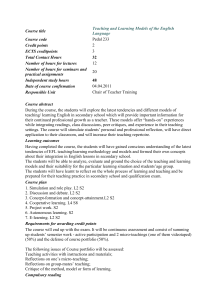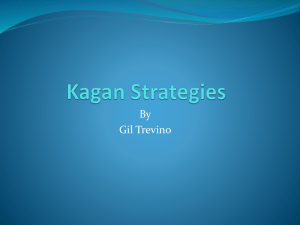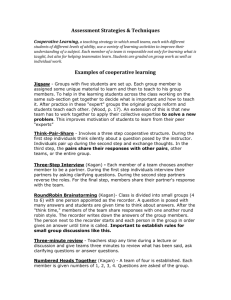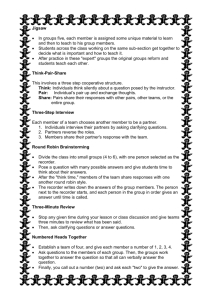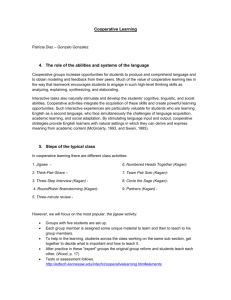cooperative learning power point read version
advertisement
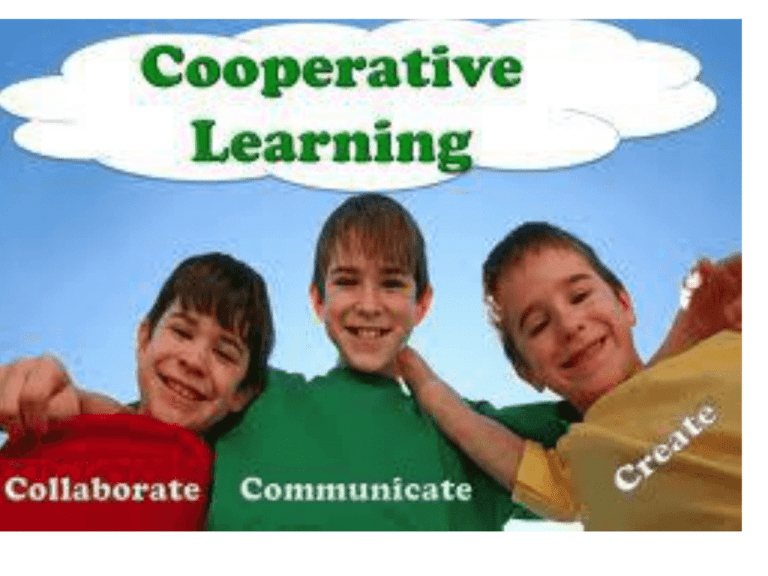
Definition • In cooperative learning students work with their peers to accomplish a shared or common goal. • The goal is reached through interdependence among all group members rather than working alone. • Each member is responsible for the outcome of the shared goal. • “Cooperative learning does not take place in a vacuum.” Not all groups are cooperative groups. Putting groups together in a room does not mean cooperative learning is taking place. (Johnson & Johnson, p. 26). 5 essential elements are needed. • Positive Interdependence • Each group member depends on each other to accomplish a shared goal or task. • Without the help of on member the group is not able to reach the desired goal. Face-to Face Interaction • Promoting success of group members by praising, encouraging, supporting, or assisting each other. • Orally explaining how to solve problems • Teaching one's knowledge to other • Checking for understanding • Discussing concepts being learned • Connecting present with past learning Individual Accountability • Each group member is held accountable for his or her work. • Keeping the size of the group small. The smaller the size of the group, the greater the individual accountability may be. • Randomly examining students orally by calling on one student to present his or her group's work to the teacher (in the presence of the group) or to the entire class. • Observing each group and recording the frequency with which each member-contributes to the group's work. • Assigning one student in each group the role of checker. The checker asks other group members to explain the reasoning and rationale underlying group answers. • Having students teach what they learned to someone else. Social Skills • Cooperative learning groups se the stage for students to learn social skills. • These skills help to build a stronger cooperation among group members. • Leadership, decision-making, trust-building, and communication are different skills that are developed in cooperative learning. Group Processing • Group Processing is an assessment of how groups are functioning to achieve their goals or tasks. • By reviewing group behavior the students and the teacher get a chance to discuss special needs or problems within the group. • Groups get a chance to express their feelings about beneficial and unhelpful aspects of the group learning process in order to correct unwanted behavior and celebrate successful outcomes in the group work. Essential Elements • A CLEAR SET OF SPECIFIC STUDENT LEARNING OUTCOME OBJECTIVES • A means to an end rather than an end in themselves. • Teachers should begin planning by describing precisely what students are expected to learn and be able to do on their own well beyond the end of the group task and curriculum unit. • Regardless of whether these outcomes emphasize academic content, cognitive processing abilities, or skills, teachers should describe in very unambiguous language the specific knowledge and abilities students are to acquire and then demonstrate on their own. ALL STUDENTS IN THE GROUP "BUY INTO" THE TARGETED OUTCOME • It is not sufficient for teachers to select outcome objectives: students must perceive these objectives as their own. • They must come to comprehend and accept that everyone in the group needs to master the common set of information and/or skills. • In selected strategies where groups select their own objectives, all members of each group must accept their academic outcomes as ones they all must achieve. CLEAR AND COMPLETE SET OF TASKCOMPLETION DIRECTIONS OR INSTRUCTIONS • Teachers need to state directions or instructions that describe in clear, precise terms exactly what students are to do, in what order, with what materials, and, when appropriate, what students are to generate as evidence of their mastery of targeted content and skills. • These directions are given to students BEFORE they engage in their group learning efforts. HETEROGENEOUS GROUPS • Organize the three-, four-, or five-member groups so that students are mixed as heterogeneously as possible, first according to academic abilities, and then on the basis of ethnic backgrounds, race, and gender. • Students should not be allowed to form their groups based on friendship or cliques. • When groups are maximally heterogeneous and the other essential elements are met, students tend to interact and achieve in ways and at levels that are rarely found in other instructional strategies. • They also tend to become tolerant of diverse viewpoints, to consider others' thoughts and feelings in depth, and seek more support and clarification of others' positions. EQUAL OPPORTUNITY FOR SUCCESS • Every student must believe that he or she has an equal chance of learning the content and abilities, and earning the group rewards for academic success, regardless of the group he or she is in. • In other words, the student must not feel penalized academically by being placed in a particular group. Class Activities that use Cooperative Learning • Jigsaw • Groups with five students are set up. • Each group member is assigned some unique material to learn and then to teach to his group members. • To help in the learning students across the class working on the same sub-section get together to decide what is important and how to teach it. • After practice in these "expert" groups the original groups reform and students teach each other. (Wood, p. 17) Tests or assessment follows. Think-Pair-Share • Involves a three step cooperative structure. • During the first step individuals think silently about a question posed by the instructor. • Individuals pair up during the second step and exchange thoughts. • In the third step, the pairs share their responses with other pairs, other teams, or the entire group. Three-Step Interview (Kagan) • Each member of a team chooses another member to be a partner. • During the first step individuals interview their partners by asking clarifying questions. • During the second step partners reverse the roles. • For the final step, members share their partner's response with the team. RoundRobin Brainstorming (Kagan) • Class is divided into small groups (4 to 6) with one person appointed as the recorder. • A question is posed with many answers and students are given time to think about answers. • After the "think time," members of the team share responses with one another round robin style. • The recorder writes down the answers of the group members. • The person next to the recorder starts and each person in the group in order gives an answer until time is called. Numbered Heads Together (Kagan) • A team of four is established. Each member is given numbers of 1, 2, 3, 4. • Questions are asked of the group. Groups work together to answer the question so that all can verbally answer the question. • Teacher calls out a number (two) and each two is asked to give the answer. Team Pair Solo (Kagan) • Students do problems first as a team, then with a partner, and finally on their own. • It is designed to motivate students to tackle and succeed at problems which initially are beyond their ability. I • t is based on a simple notion of mediated learning. Students can do more things with help (mediation) than they can do alone. • By allowing them to work on problems they could not do alone, first as a team and then with a partner, they progress to a point they can do alone that which at first they could do only with help. Circle the Sage (Kagan) • • • • • • • • • • First the teacher polls the class to see which students have a special knowledge to share. For example the teacher may ask who in the class was able to solve a difficult math homework question, who had visited Mexico, who knows the chemical reactions involved in how salting the streets help dissipate snow. Those students (the sages) stand and spread out in the room. The teacher then has the rest of the classmates each surround a sage, with no two members of the same team going to the same sage. The sage explains what they know while the classmates listen, ask questions, and take notes. All students then return to their teams. Each in turn, explains what they learned. Because each one has gone to a different sage, they compare notes. If there is disagreement, they stand up as a team. Finally, the disagreements are aired and resolved. PROS • “Research shows that cooperative learning promotes both intellectual and emotional growth” (Sadker&Sadker) • 1. Student achievement is higher • 2. Students have higher levels of self-esteem and greater motivation to learn • 3. Students can sense the positive regard they have for one another • 4. Understanding and cooperation among students from different racial and ethnic backgrounds are enhanced Pros • Research shows that cooperative learning improves achievement and relationships (Santrock). • Students of different ethnic backgrounds when working together, learn to respect each other, as well as focus on higher academic goals. CONS • Research also shows that cooperative learning can be a hardship to students when a group is not well developed. • There is a great burden placed on children in the cooperative learning group. • The great burden is making them responsible for each other’s learning apart from themselves. • “One study showed that in groups of mixed ability, low-achieving students became passive and did not focus on the task .” (Johnson, D. July 1999)
